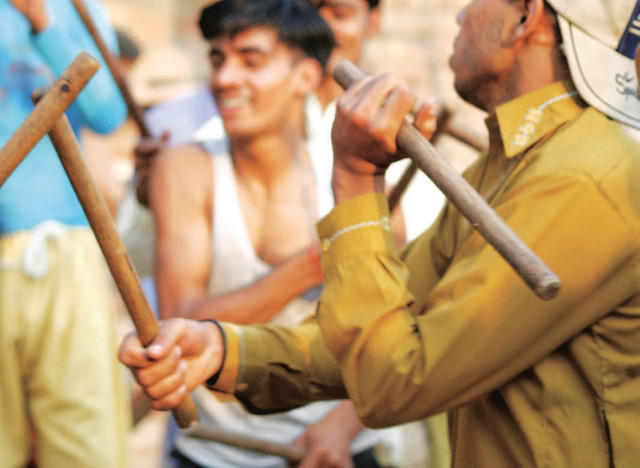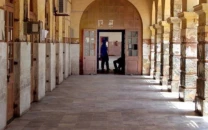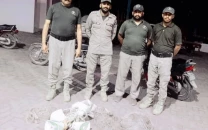Celebrating Vaisakhi at Ram Thamman II
In part 2 of his account of this annual festival, the writer celebrates the subcontinent’s religious syncretism.

According to the Encyclopedia of Sikh Literature written by Bhai Kan Singh Nabha, Baba Ram Thamman was the elder cousin of Guru Nanak and, like him, a saint. Hindu Udasis (a sect within Hinduism) and Sikhs hold Ram Thamman in high regard, though at the festival I notice a show of reverence from Muslims too. Ram Thamman belonged to the neighbouring village of Kalu Khara and like other saints, he choose to meditate outside the village. When he died, a smadh was constructed where he used to sit. Over the years, as more devotees began to visit the smadh, the complex was enlarged. Boundary walls spread over an expanse of 22 acres were built to include various structures including havelis. After Partition, refugees from India began to establish themselves in the vacant buildings and rooms left behind by the fleeing priests. Since then, many modifications have been made to the complex, though, if you look closely, you can identify faint remnants of the original structure. Local people say that there were elaborate frescoes on the wall including those of Hindu deities and mythological characters. Much of that has been lost too — some have simply withered away with time and others have been painted over by the inhabitants.
Most shrines contain pools where devotees perform ashnan (religious bathing). The eight acre pool at Ram Thamman faces the smadh and but it is no longer in use. Over the years, competing systems of irrigation led to the blockage of conduits that provided fresh water to the pool and drew stale water out. For years now, stale water has stagnated in this pool. Pandit Bhagat Lal Khokhar, a Hindu priest at the Neela Gumbad Valmiki Temple, says that he used to visit the festival at Ram Thamman as a child. He says that according to legend, Hanuman excavated this pool with a shovel by digging it only two and a half times. Hanuman, the monkey deity is known for his bravery and strength and is a passionate follower of Ram (the mythological Hindu King).
Hussain — whose grandfather used to live here — tells me that Vaisakhi has been celebrated in this village for 1,200 years. Believing these accounts would imply that Ram Thamman is an ancient mythological site such as the Katas Raj in Chakwal district, and not simply a shrine. But the Encyclopedia of Sikh Literature makes no such claims and one cannot prove Ram Thamman’s significance in light of Hindu mythology.
Muslim attendees at the festival acknowledge the fact that Ram Thamman is a Hindu shrine but, out of custom, they come to pay their respects. Vaisakhi however, sees Christian participation too. Some Christians are residents of the village while the rest come from Lahore. Many are converts who became Christian after Partition to avoid the stigma of being ‘untouchables’. So most of them retain their Hindu practices.
Durga Pooja is an occasion where pilgrims travel many kilometers bare-footed, carry flags with them and chant “Jee Mata Ki!” as they move towards the temple. Here they offer the Mata a chunri and make their wishes to the deity. One finds similar traditions in Sufism as well where devotees travel many miles in groups during the Urs of a saint and chant Sufi poems. Instead of chunri however they carry a green chadar with verses from the Quran written on it that they spread over the grave of the Saint.
This year a group of seven or eight performers come from Kasur with a chadar that they want to offer to Baba Ram Thamman. They perform a traditional folk dance called the Dandiya Raas in which the performers dance in pairs with two wooden sticks while a dhol plays in the background. It is often performed during Holi, Nauratri and other cultural festivals. Ghulam Ali, 22, tells me that he has been performing the dance for 15 years and that the dance group has performed in various shrines such as Bulleh Shah, Data Darbar and Pak Pattan. They have come on their own accord to perform at this festival and people mostly offer them ‘wail’ (money given voluntarily).
Over the last few years, religious syncretism has seen an acute decline in Pakistan as Islamic purists have gained strength. The daredevil from last week’s article, Ahmad, tells me with pride that there was a time he used to perform all over the country, at shrines like Data Darba, Baba Fareed Shakar Ganj, Sakhi Sarwar and many more. He adds that for the past few years they have not been able to perform in any large cities due to security concerns.
Muhammad Saleem, a local villager, tells me: “Some maulvis find these festivals un-Islamic and so they seek the help of the police and try to ban the use of loudspeakers.” Saleem, who has never been to school adds, “It is a festival which provides people with catharsis — an outlet to vent their frustrations.” He says that despite the rise in Islamic purists, people still attend the festival in large numbers. One notices similar trends in other villages such as Nauratri at Bahawal Nagar and the festival of Lohri at Nankana Sahib. This indicates that even though larger cities are becoming nationalistic in their outlook, culture is very much alive in smaller towns.
Published in The Express Tribune, Sunday Magazine, July 10th, 2011.



















COMMENTS
Comments are moderated and generally will be posted if they are on-topic and not abusive.
For more information, please see our Comments FAQ